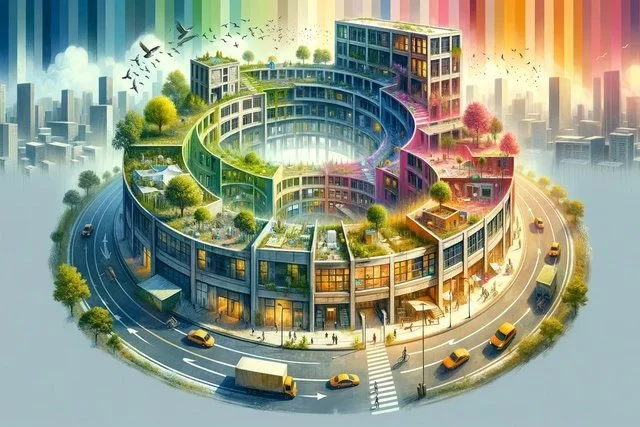The Carbon Measurement Glowup
In the first of our ‘Building Change’ series, Rebecca Mills, founder of The Lever Room, summarises the present state of carbon accounting in New Zealand and finds it on the cusp of a transformation.
In a pivotal decade where global emissions must be halved, the design, building, and construction sector in New Zealand must rise up as a crucial player in this endeavour.
While this sector currently contributes around 15% of the nation’s greenhouse gases, its significance on a global scale cannot be overstated, accounting for over one-third of global energy consumption and emissions.
In committing to the The Paris Agreement in 2016, the New Zealand Government has set ambitious targets to reduce carbon emissions, aiming for a 50% reduction in net emissions by 2030. Sustainable design coupled with precise, localised carbon measurement data is instrumental in achieving these goals.
We must take an analytical and judicious approach to how we currently measure carbon emissions and reject outdated approaches to carbon accounting if we are to accurately account for emissions. By embracing innovative strategies, we can pave the way for a more resilient and low-emission future.
Often overlooked is the long-term impact of our buildings, which sets emissions patterns for the future and influences emissions across various sectors. With projections indicating a 75% increase in floor area over the next 30 years, the need for decarbonisation efforts in the sector becomes even more pressing.
Acknowledging that the construction sector is a significant contributor to greenhouse gas emissions and waste, it’s clear that rapid transition toward net-zero carbon practices is essential to mitigate climate change and preserve nature.
The multi award-winning Scion Innovation Hub by RTA Studio and Irving Smith Architects. Image: Patrick ReynoldsAre architects New Zealand’s next sustainability champions?
Architects and professionals in the building and construction sector have a unique opportunity to lead the way in innovating and adapting to low-emission methods. By focusing on reducing both operational and embodied carbon emissions, we can make substantial strides toward a more sustainable built environment.
In the book Design for a Radically Changing World (Pub(d). 2024) by co-chairs of Gensler, Diane Hoskins and Andy Cohen, they write:
“Too often, the idea of design is limited to aesthetics. Design, however, is about impact. It creates the buildings and spaces in which we live, which shape us in profound ways.”
Believers in the inherent optimism of design, but also its problem-solving abilities, they continue: “We are beginning to see a new chapter in design, one that reflects humanity’s broader worldview.”
This shift in worldview — catalysed by climate change — is ushering in a movement in architecture that focuses on wellness, sustainability, reducing carbon emissions and long-term environmental integrity.
Locally, innovative new design and construction techniques are being adopted to reduce carbon outputs and demonstrate respect and admiration for te ao Māori (the Māori world view), which encompasses a sensitivity to and respect for the natural world.
In the words of Nat Cheshire, Director at Cheshire Architects, “If we’re not focusing on te taiao [the natural world], we’re writing ourselves into insignificance, missing the one exhilarating opportunity for our art to affect massive, desperate pan-human change.”
The introduction of stricter carbon measurement standards, including mandatory reporting requirements and caps on embodied carbon, signals a positive shift toward more comprehensive emission reduction strategies.
Stricter carbon measurement is coming
In 2020, the Ministry of Business Innovation and Employment (MBIE) consulted with the building and construction sector on proposals to introduce mandatory reporting requirements and eventually caps for the whole-of-life embodied carbon of buildings. Sector feedback indicated support for these proposals.
The Government consulted on a ‘Whole-of-Life Embodied Carbon Reduction Framework’ in 2020. The framework would require reporting and measurement of whole-of-life embodied carbon emissions — from manufacturing building materials to disposing of them at the end of a building’s life. The framework would cap new buildings’ whole-of-life embodied carbon and reduce the cap over time.
Over time, the levels of emission reduction required will increase. There’ll be a focus on a broader range of measures including new regulatory requirements, behaviour change programs, incentives and support for new technologies and innovation.
Taking a circular approach, a whole-of-life building assessment takes into account the footprint, construction, operational emissions, structural sustainability, and maintenance of a building over its lifetime. Image: Xiaohu Yan, Sandra Baggerman, Cas Esbach via MidjourneyDefining a building’s whole-of-life embodied carbon
The embodied carbon of a building is the sum of all the greenhouse gas emissions that occur at each stage of its life cycle. Emissions are measured in units of kg CO2-e. In LCA studies, they are reported in the environmental impact category known as ‘Global Warming Potential’ (GWP).
A building’s whole-of-life embodied carbon according to the technical method released by MBIE in 2022:
is the sum of the embodied carbon of the constituent materials and products in the building, to the extent that it includes those elements that make the most significant contribution to the total embodied carbon of the building,
includes all the emissions associated with these materials and products that occur right across their lifecycle, namely production and manufacture, transportation and construction processes, maintenance activities, and what happens when the building is no longer used (end-of-life),
excludes emissions associated with the operation of the building, typically from energy used for heating, cooling, lighting, and water consumption.
The mandatory scope of an embodied carbon assessment shall initially include the significant elements of a new building that perform the primary functions of the building.
Impact measurement is fast-evolving
Clear organisational and project-specific sustainability strategies, coupled with robust carbon measurement and impact assessments, will become standard practice for architecture and engineering firms. Collaborating with organisations specialising in carbon measurement and lifecycle analysis is key to navigating this evolving landscape effectively.
As with any fairly new and complicated process, there are still issues to overcome in getting our facts straight.
In 2022, the New Zealand Green Building Council (NZGBC) did some work with Thinkstep-anz and industry in an attempt to standardise the methodology for calculating embodied carbon. One of the issues that inspired the collaboration was the inconsistencies between one company’s approach to the next, resulting in figures that fluctuated greatly.
Together they created a new carbon calculator that offers a consistent approach to scope and calculation — and when striving for certifications like Green Star this methodology enables the NZGBC to compare the results against set benchmarks.
Armed with a clear methodology, a definitive consensus as to what should and shouldn’t be included in these data sets is the next milestone. The Lever Room is currently working with an architect to fill in the gaps in LCAQuick, an excel calculator that The Building Research Association of New Zealand (BRANZ) released in 2023.
The key to all of this is who has oversight of the numbers to ensure consistent scope. Irrespective of Government regulations, people are going to be asking for transparency and verification so it is a risk for architects to get it wrong or not be comprehensive.What’s considered “green” and what’s not will largely depend on the accuracy of the tools used to measure a building’s past, present, and future impact. Image: Xiaohu Yan, Sandra Baggerman, Cas Esbach via Midjourney
Architecture and engineering firms will need to have in place clear organisational and project-specific sustainability strategies, carbon measurement and impact assessments and there are several organisations in New Zealand that can help develop these.
The New Zealand market currently consists of audit and certification organisations such as Toitū, Ekos and The Lever Room. Furthermore, there are a number of science-based practitioners, including Thinkstep-anz and The Lever Room, that have the additional capability to advise on how to best streamline and undertake the heavy lifting on carbon measurement and lifecycle analysis.
As we transition toward mandatory reporting and caps for embodied carbon, it’s increasingly important to recognise the limitations of generic LCA tools and embrace more nuanced approaches tailored to local contexts. While challenges may arise, working alongside sustainability experts with extensive experience and global connections will ensure resources are well spent and that efforts are focused on the most impactful initiatives.
Conclusion
In conclusion, while the road ahead may present challenges, it also provides opportunities for innovation and positive change. By embracing sustainable design practices, leveraging precise carbon measurement techniques, and fostering collaboration across sectors, we can forge a path toward a more sustainable and resilient future for generations to come.
About the writer
Rebecca Mills, Managing Director, The Lever Room.
Rebecca Mills is a strategist in delivering and measuring sustainability and climate impact. She is the founder of The Lever Room, New Zealand’s leading carbon measurement provider. In her Lever Room role she has lifted up a number of national level initiatives, including supporting the development of Homestar Residential Rating Tool on behalf of NZGBC.
Mills was shoulder-tapped to co-design the strategy with Sir Richard Branson and Jochen Zeitz for what is now known as The B Team — a group of business leaders to advocate for business practices more centred on humanity and the climate. She has worked on some of the UK’s largest regeneration sites in her role as former Principal of Sustainable Design and Construction for the UK’s Environment Agency.
Most recently, Mills and her team have shared a new carbon certification approach and have been utilising remote sensing and field plot data to enhance and simplify carbon sequestration measurement. She has a Masters of Biosphere Science and impact measurement training from Saīd Business School.
She currently lives and works in Grey Lynn, Tāmaki Makaurau.



